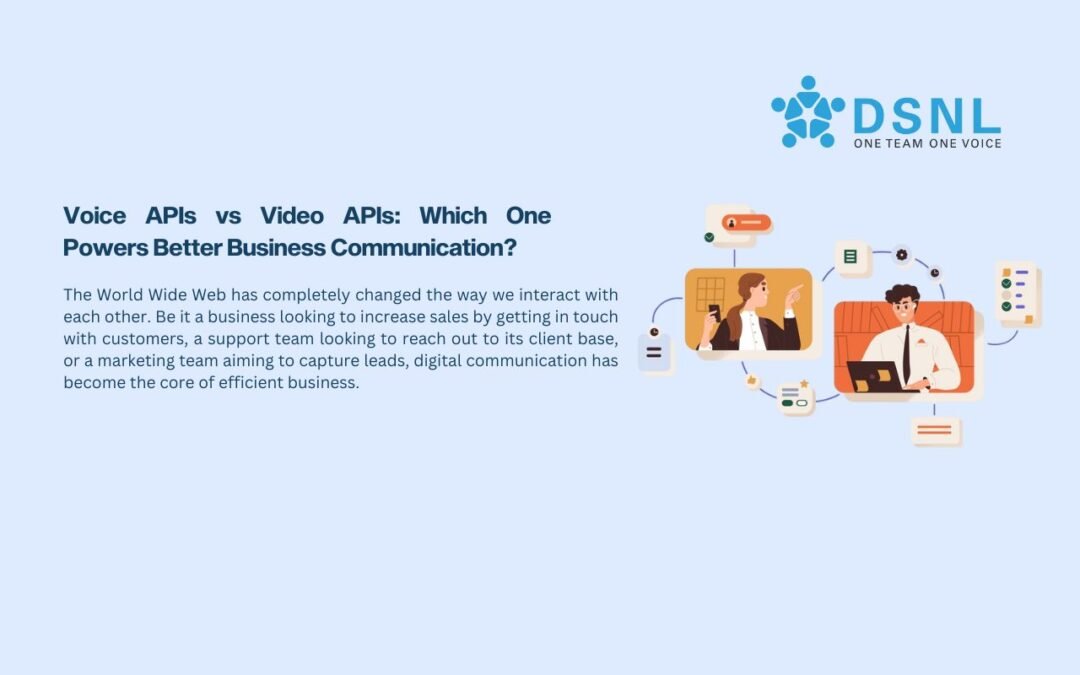The World Wide Web has completely changed the way we interact with each other. Be it a business looking to increase sales by getting in touch with customers, a support team looking to reach out to its client base, or a marketing team aiming to capture leads, digital communication has become the core of efficient business. And as the business is moving towards digital, there are two technologies that have played a pivotal role in this transformation, Voice APIs and Video APIs. But when it comes to having the most impact on business, which of the two takes the cake? Well, that depends on multiple factors such as reliability, user experience, accessibility, and the current infrastructure.
One of the companies which has gained the trust of clients through business communication platforms such as IVR, voice bots, and automated voice-based interactive experiences, is DSNL. They help businesses, large and small, by streamlining business communication through their audio-first solutions.
Understanding Voice APIs in Business Contexts
Voice APIs are designed to provide calling functionality within apps, software, and on the web. They enable businesses to build secure and interactive voice experiences, whether for inbound call support, outbound campaigns, or automated phone systems.
Voice integration is reliable. PSTN-based calling services ensure consistent and reliable call quality, even in low-data connectivity areas, like in India. The providers offering clear audio conferencing India through Voice APIs, ensure that there are no disruptions in the flow of calls, regardless of the device or the location.
Voice APIs are suitable for high-frequency use cases such as appointment reminders, account verification, IVR routing, and voice-based customer engagement. They integrate with CRMs, contact centers, and mobile apps to provide a low-friction experience to the users and consistent brand communication.
The Rise and Role of Video APIs
On the other hand, video APIs have seen growing use in areas that require video interaction. Examples include healthcare, education, and high-end sales, all of which have adopted video conferencing tools for remote appointments, training, and consulting.
Video APIs typically carry higher technical overheads. They can demand greater bandwidth, software compatibility, and hardware readiness to create a satisfying experience. However, the video meeting platforms that offer browser-based web conferencing India services with no app downloads have mitigated some of these issues, but audience and infrastructure support will ultimately dictate adoption.
Video adds a richer layer of visual context but also carries the risk of engagement dead ends from connection drops, AV sync issues, and eye fatigue. For situations where speed, clarity, and broad reach are priorities, video can be too much overhead.
Accessibility and Device Agnosticism
Another reason why many businesses are so committed to voice APIs is that voice is highly accessible on any device. With a landline, smartphone, or desktop browser, voice can be dialed and made accessible to anyone without advanced hardware. This is critical in a customer service setting where participants don’t want to be waiting and want to be heard.
Voice broadcast solutions that use APIs give enterprises the ability to reach millions of users in mass outbound campaigns without any of those users needing to install software or turn on webcams. This helps in onboarding, and ensures that more people participate in these campaigns, which is especially true for regional and rural communities.
Security and Integration Flexibility
Both Voice and Video APIs support encrypted channels and customizable routing. However, voice integrations are faster to deploy and need less backend change for Cloud-based contact center India, and thus are better suited for businesses who want to go live quickly and are not relying on much on IT overhead.
Furthermore, voice APIs integrate seamlessly with business API messaging services and create multichannel workflows where calls and messages work together. For example, a follow-up WhatsApp after a missed call is a feature expected from modern customers.
Choosing What Powers Better Communication
At the end of the day, Voice APIs do not replace Video APIs. Rather, they are just as a tool to fit the need. If a video feed is ideal, then the video API makes sense. If the application is better suited for a voice feed, then Voice APIs would make more sense. With the latter being faster, cheaper, and simpler, these features are ideal for support, notifications, and sales follow-ups.
For video feed, we want face-to-face interaction and visual support, which are offered by the video APIs. As for businesses and entities that are focused on making communication affordable, effective, and stable, Voice APIs are the preferred choice as compared to Video APIs. With new innovations being rolled out by providers like DSNL, there is a lot of room for the combination of the two technologies.
Conclusion
So at the end of the day, great communication is not about the shiniest tool. It’s about picking the right one. Voice or video, the best API is the one that delivers the experience, the access, and the outcomes. And for many real-time, high-impact business moments, voice is still the power behind connection and clarity.

